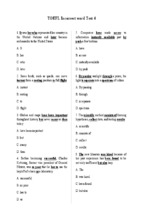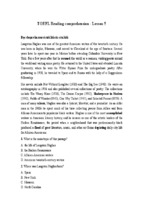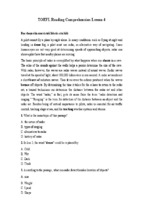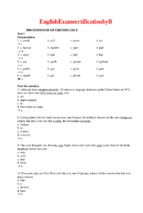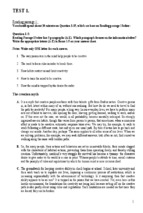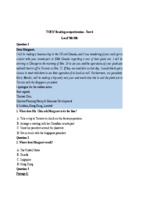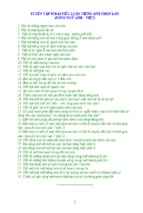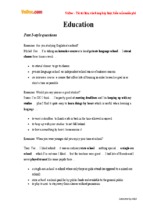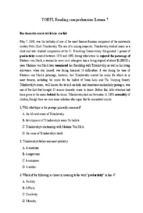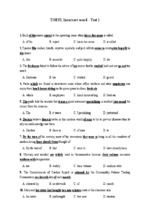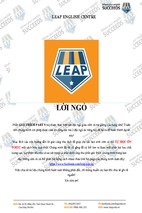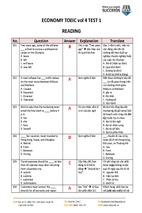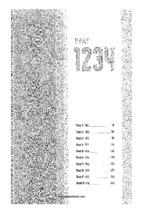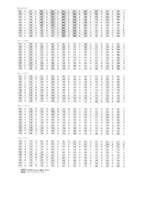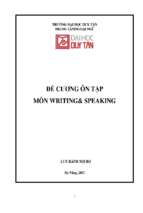L e a r n i n g E x p r e s s ®’ s
®
GMAT EXAM
SUCCESS
In Only 4 Steps!
L e a r n i n g E x p r e s s ®’ s
®
GMAT EXAM
SUCCESS
In Only 4 Steps!
Elizabeth Chesla
and Colleen Schultz
®
NEW
YORK
Copyright © 2003 LearningExpress, LLC.
All rights reserved under International and Pan-American Copyright Conventions.
Published in the United States of America.
Library of Congress Cataloging-in-Publication Data:
Chesla, Elizabeth L.
GMAT exam success in only 4 steps / Elizabeth Chesla and Colleen
Schultz—1st ed.
p. cm.
Includes bibliographical references.
ISBN 1-57685-472-8
1. Graduate Management Admission Test—Study guides.
2. Management—Examinations, questions, etc. I. Schultz, Colleen.
II. Title.
HF1118.C44 2003
650'.076—dc21
2003009065
Printed in the United States of America
987654321
First Edition
ISBN 1-57685-472-8
For more information or to place an order, contact LearningExpress at:
55 Broadway
8th Floor
New York, NY 10006
Or visit us at:
www.learnatest.com
About the Authors
Elizabeth Chesla is the author of TOEFL Exam Success, ACT Exam Success, GED Success, Reading Comprehension Success, Write Better Essays, and many other writing and reading guides and test preparation books.
She lives in South Orange, New Jersey.
Colleen Schultz is a math teacher from Binghamton, New York. She is a contributing writer for 501 Math
Word Problems, 501 Quantitative Comparison Questions, and an item writer for several high-stakes math tests.
Contents
PART I
Preparing for the GMAT
1
Chapter 1
About the GMAT
3
Chapter 2
Overview of the GMAT
Computer-Adaptive Test
Preparing for the Computer-Based GMAT Exam
How the GMAT Is Scored
Getting Your Scores to Schools
Retaking the Exam
GMAT Testing Center Rules and Regulations
Registering for the GMAT Exam
Paying for the GMAT
4
6
7
9
12
12
13
16
20
GMAT Study Skills
21
Where Do I Start?
I Need a Plan
I Need a Place
The Right Tools
The Study Plan
You Are Worth It: Motivational and Relaxation Techniques that Work
Learning Strategies and Test-Taking Techniques
Testing Psychology
21
23
26
30
31
34
37
40
vii
–CONTENTS–
How to De-Stress
Stay Healthy
Multiple-Choice Strategies
The Endgame
41
43
44
45
PART II
The GMAT Verbal Section
49
Chapter 3
Verbal Pretest
51
Questions
Answer Explanations
52
58
What to Expect on the GMAT Verbal Section
63
Reading Comprehension Questions
Critical Reasoning Questions
Sentence Correction Questions
64
65
66
Reading Comprehension
69
Active Reading
Finding the Main Idea
Distinguishing between Fact and Opinion
Identifying Specific Facts and Details
Essay Types and Organizational Patterns
Making Inferences
69
72
76
78
79
83
Critical Reasoning
87
Elements of an Argument
Complicating Arguments
Evaluating Arguments
87
89
93
Chapter 4
Chapter 5
Chapter 6
Chapter 7
Chapter 8
Sentence Correction
109
24 Rules for Grammar and Style
Sentence Structure
Grammar and Usage
Style
110
111
119
128
Tips and Strategies for the Verbal Section
137
Reading Comprehension Questions
Critical Reasoning Questions
Sentence Correction Questions
138
139
141
viii
–CONTENTS–
Chapter 9
Verb Forms
143
Regular Verbs
Irregular Verbs
Helping Verbs
Subjunctive Mood
Troublesome Verbs
Gerunds and Infinitives
145
146
150
150
151
152
Prefixes, Suffixes, and Word Roots
155
Prefixes
Suffixes
Common Latin Word Roots
Common Greek Word Roots
155
160
162
164
Verbal Section Practice Test
169
Questions
Answer Explanations
170
193
Chapter 12
Verbal Section Glossary
207
PART III
The GMAT Analytical Writing Assessment
211
Chapter 13
Pretest
213
Questions
Answer Explanations
214
218
About the Analytical Writing Assessment
221
Analysis of an Issue
Analysis of an Argument
How the Essays Are Scored
221
223
225
Guide to Effective Writing
231
The Writing Process
Seven Steps for Writing a Strong AWA Essay
Writing with Style
Writing Correctly: The Conventions of Standard Written English
150 Most Commonly Misspelled Words
231
236
248
252
265
Chapter 10
Chapter 11
Chapter 14
Chapter 15
ix
–CONTENTS–
Chapter 16
Tips and Strategies for the AWA
267
General Writing Strategies
Analyzing the Issue
Analyzing the Argument
267
269
269
AWA Practice
271
Analysis of an Issue Sample Prompts
Analysis of an Argument Sample Prompts
Answers and Explanations
272
282
292
PART IV
The GMAT Quantitative Section
305
Chapter 18
Quantitative Pretest
307
Problem Solving Questions
Data Sufficiency Questions
Answer Explanations
308
310
312
About the Quantitative Section
317
About the Types of Questions
318
Arithmetic
321
Types of Numbers
Properties of Numbers
Order of Operations
Special Types of Defined Operations
Factors, Multiples, and Divisibility
Prime and Composite Numbers
Even and Odd Numbers
Consecutive Integers
Absolute Value
Operations with Real Numbers
321
322
323
324
325
327
327
328
328
328
Algebra
339
Translating Expressions and Equations
Combining Like Terms and Polynomials
Laws of Exponents
Solving Linear Equations of One Variable
Solving Literal Equations
Solving Inequalities
339
340
341
341
342
343
Chapter 17
Chapter 19
Chapter 20
Chapter 21
x
–CONTENTS–
Multiplying and Factoring Polynomials
Solving Quadratic Equations
Rational Expressions and Equations:
Coordinate Graphing
Systems of Equations with Two Variables
Problem Solving with Word Problems
Functions
Chapter 22 Geometry
344
344
347
349
350
352
355
357
Angles
Polygons
Triangles
Quadrilaterals
Circles
Measurement and Geometry
358
359
360
363
364
365
Chapter 23
Tips and Strategies for the Quantitative Section
367
Chapter 24
Quantitative Practice Test
369
Questions
Answer Explanations
370
387
Chapter 25
Quantitative Section Glossary
397
Appendix A
GMAT Online Resources
401
Appendix B
GMAT Print Resources
403
xi
P A R T
I
Preparing for
the GMAT
C H A P T E R
1
About the
GMAT Exam
Planning to apply to a graduate business or management degree
program? Then you need to find out all you can about the GMAT®
exam so you can do your best on the exam. This chapter will tell you
everything you need to know to get started. You will learn how the
test is structured and scored, how to register, and what procedures
and regulations to expect at the testing center.
A graduate degree in business or management can transform your professional life, opening the door to promotions, new opportunities, and new careers. For better or for worse, which business school you attend
depends to some degree upon how well you do on the Graduate Management Admissions Test® (GMAT®).
Like the SAT® exam, ACT Assessment®, and GRE® test, the GMAT exam is a standardized test designed
to help schools determine how well you might succeed in their graduate program. Of course, the GMAT exam
is just one of the tools schools use to assess a candidate’s knowledge and skills, and it is by no means a definitive measure. But it is an important test, and because your scores can determine your eligibility for certain
programs and give you an edge over other candidates, it is important that you do well on the exam.
The GMAT exam is sponsored by the Graduate Management Admission Council® (GMAC®), a nonprofit association of representatives from business schools around the world. Nearly 2,000 business schools
use the GMAT exam, which is developed and administered by the Educational Testing Service® (ETS®), the
same organization that develops and administers a number of other standardized tests including the SAT and
TOEFL® exams. The majority of people taking the GMAT exam seek to enter MBA programs, but an increasing number of other graduate business and management programs are now offered, and many of these programs also use the GMAT exam to assess the qualifications of applicants.
3
On the Road to a Graduate Degree
Although the MBA is still the most popular graduate business degree, a growing number of other graduate-level
business and management programs are becoming available. Taking the GMAT exam can help you apply for
programs that offer several different graduate degrees, including the following:
• Master of Business Administration (MBA)
• Master of Science in Management
• Master of Public Administration (MPA)
• Master of Science in Financial Engineering
�
An Over view of the GMAT Exam
Nearly 50 years ago, the GMAC was founded with the goal it maintains today: to develop a standardized
assessment tool for business school candidates. Although the GMAT exam has evolved over the years, the
three-and-a-half-hour exam still tests candidates in three main areas, measuring analytical writing, verbal,
and quantitative skills.
The Analytical Writing Assessment (AWA)
The first part of the GMAT exam, the Analytical Writing Assessment (AWA), is designed to measure your ability to analyze ideas and to write clearly and effectively about those ideas. You will be asked to write two separate essays: one that analyzes an issue and one that analyzes an argument. You will have 30 minutes for each
essay.
In the Analysis of an Issue section, you will be presented with a short passage (one paragraph) about
an issue, such as whether new technologies create or destroy more jobs or whether education is the most
important key to success. You will be asked to take a position on this issue and explain your position. In the
Analysis of an Argument section, you will be presented with a short argument (again, just one paragraph)
and be asked to critique that argument. In this essay, you should not present your own point of view but rather
assess the logic of the argument that has been presented.
In both cases, the topics will be general enough for every test taker to write about. Prior knowledge of
the subject matter may be helpful, but it is not required. It is more important to show your ability to take and
support a position and your ability to analyze the effectiveness of an argument.
The Quantitative Section
The Quantitative section is the second part of the test and includes 37 multiple-choice questions covering two
areas of mathematics: data sufficiency and problem solving. You will have 75 minutes to answer these
questions.
The problem solving questions will constitute approximately 60% of the exam (22 questions). The problems will test your knowledge of basic math facts and skills covered in high school, including arithmetic,
4
GMAT Exam Facts
• Over 1,700 schools/programs use GMAT scores in the admissions process.
• The first GMAT exam was developed and administered nearly 50 years ago.
• In 2002, over 150,000 people took the GMAT exam in the United States.
• In 2002, over 75,000 people took the GMAT exam in locations outside the United States.
• Nearly 7% more GMAT exams were given in 2002 than in 2001 in the United States.
• Over 4% more GMAT exams were given elsewhere in the world in 2002 than in 2001.
• Approximately 20% of people who take the GMAT exam take it more than once. Most repeat testers take
the test two or three times.
algebra, geometry, word problems, and interpreting charts and graphs. These questions will emphasize your
understanding of mathematical concepts, although you will also need to know basic math procedures in order
to select the correct answer.
The data sufficiency questions constitute the remaining 40% of the test and are quite different in nature.
For these questions, you do not actually need to solve a problem or make a calculation. Instead, you will be
presented with two items of information and a question. You must determine whether the information presented is sufficient to accurately answer the question or if you need more data to solve the problem. The
answer choices will ask you to identify which item of information is insufficient if more data is indeed
required.
The Verbal Section
The third and final part of the GMAT exam is the Verbal section. You will have another 75 minutes to answer
41 multiple-choice questions. These questions cover three areas: reading comprehension, critical reasoning,
and sentence correction. Approximately one-third of the questions will fall into each category.
The reading comprehension questions will be based on short passages (150 to 350 words) about topics ranging from the social sciences to the physical and biological sciences to business, the arts, and humanities. You may be asked about the main idea of the passage, the author’s support for that main idea,
argumentative strategies, specific facts and details in the text, and inferences that can be drawn from the passage. You can expect the passages to be rather sophisticated, much like the reading material you will be
exposed to in business school.
The critical reasoning questions present you with a short reading passage (50 to 100 words) that makes
an argument about a general topic. You will be asked about the structure of the argument, including its
conclusion and assumptions; about the quality of the argument, including its strengths and weaknesses; and
about plans of action based upon the argument, including what actions are appropriate and effective based
on the text. Again, this is great training for the business world.
The sentence correction questions present you with a sentence with part or all of the sentence underlined. You must choose the answer that best expresses the idea of the sentence. To determine the best answer,
you will need to consider the grammar and usage, diction, sentence structure, sentence logic, and tone.
5
What the GMAT Exam Is and Is Not
Like all standardized tests, the GMAT exam is just one measure of your potential success in a graduate business or management program. A strong correlation can be made between high performance on the GMAT exam
and success in the first year of business school. However, the exam is designed to measure a targeted set of
knowledge and skills, and does not take into account other factors that are essential to academic success.
The GMAT exam is designed to measure the following:
• your ability to take a position on an issue and support it
• your ability to critique an argument
• your ability to organize ideas and convey them clearly in writing
• your ability to express your ideas in logical, correct, and effective sentences
• your ability to conduct basic mathematical operations
• your ability to determine what data is necessary to solve problems, especially those you might encounter
in real business situations
• how well you understand what you read
• your ability to identify the logic and assumptions behind an argument
• your knowledge of techniques and strategies for effective writing
• your knowledge of the conventions of standard written English
The GMAT exam is not designed to measure the following:
• what you know about business or technology
• your job skills and experience
• your computer skills
• how well you study or manage your time
• your ability to manage others
• your interpersonal skills
• how well you learned content from your specific undergraduate or other degree areas
• other important character traits, such as your level of motivation, creativity, and self-discipline
�
Computer-Adaptive Test (CAT)
Computer technology has transformed standardized tests in many ways. In the past, people who took the
GMAT exam would all receive the same test (or one of several versions of the same test). Now, with its new
computer-adaptive format, the GMAT exam’s Quantitative and Verbal sections present each test taker with
a unique test designed to more accurately measure his or her ability in the subject.
On the GMAT exam, your questions will be drawn from a pool of possible questions, beginning with
a question of moderate difficulty. This process of dynamic question selection will continue throughout the
entire test. Each question will be selected based upon the level of the previous question and whether or not
6
Why a CAT?
The GMAC has switched the GMAT exam from a paper-based exam to a CAT for several reasons. One reason
is that computer tests are cheaper to develop, administer, and score than traditional paper exams. Another reason is that computer-adaptive exams help maintain the confidentiality of test items and prevent cheating on the
exam. Because no two test takers ever have the same test, it is very difficult for individuals to assist each other
during the exam.
More importantly, for business schools, the CAT (at least ostensibly) provides a more accurate measure of
a student’s verbal and quantitative ability than paper-based exams. For test takers anxious to know their scores,
the CAT provides an instant (but unofficial) score for the Verbal and Quantitative sections of the exam.
you answered that question correctly. The test continuously adjusts to your skill level. The computer-adaptive
test (CAT) is designed to adjust the level of difficulty of the questions to the performance of the test taker.
This means that if you answer a question of medium difficulty correctly, the next question will probably be
more difficult. However, if you answer it incorrectly, the next question will probably be easier. On a CAT, you
earn more credit for answering a hard question correctly than for answering an easy question correctly.
However, the questions will not increase in difficulty infinitely if you continue to answer all questions correctly, or at least the level will not increase at the same rate. The degree of change will be significantly lower
because the program considers your answers to every question you have answered so far, not just the current
question. The more questions you answer, the more knowledge about your skill level the computer has, and
the less dramatic the change in level will be as you proceed through the exam. Indeed, by the fifth or sixth question, the CAT is likely to have honed in on the skill level it believes is appropriate for you. Thus, an important
test-taking strategy for the GMAT exam CAT is to answer the first five or six questions correctly. Doing so will
set your questions at a higher level for the exam, enabling you to earn more credit for each correct answer.
In the Quantitative and Verbal sections, you must answer each question in the order in which it is presented. Unlike a paper-based exam, the computer-based exam does not allow you to skip questions and come
back to them later; you must answer as you go. You also cannot change your answer to a previous question
or see the questions that follow.
Because the test is timed, you must be sure not to spend too much time on any one question. On a CAT
such as the GMAT exam, your best bet is to take an educated guess at questions you cannot answer. If you
can eliminate one or two choices, you dramatically increase your chances of answering correctly and can then
move on to the next question. This is important because, as you will see in the scoring section, the number
of questions you answer is a key factor in your score.
� Preparing for the Computer-Based GMAT Exam
Taking a computer-based test is a very different experience from taking a traditional paper-based exam.
Although the Verbal and Quantitative sections require very little computer skill, you will need some basic
computer experience. More important, you need at least minimal word-processing skills to complete your
7
Practice Your Computer Skills
On the GMAT computer-based test, you will need to know the following:
• how to use a mouse
• how to enter an answer
• how to move to the next question
• how to use a word processor (for typing your AWA essays)
• how to use the HELP function
The GMAC offers a free tutorial to help you become comfortable with the computer skills you will need for the
GMAT exam. You can download this software from the GMAT website at www.mba.com/mba/TaketheGMAT/
ToolsToHelpYouPrepare/GMATPrepProducts/GMATTutorialsSoftware.htm.
NOTE: The tutorial is not compatible with Macintosh® computers.
AWA essays. You are already under enough pressure to try to write two essays in an hour. If you are not comfortable typing, and if you do not know basic word-processing functions such as how to delete or move text,
you may have a difficult time writing a successful essay.
If you are not experienced with computers, then part of your GMAT exam preparation time must
include learning computer skills. Here are some specific tips to help you improve your computer skills to reach
peak performance on the GMAT exam:
■
■
■
■
■
Practice using a mouse. Get comfortable with the movement of the arrow and clicking around on the
computer screen.
Learn how to move up and down a page. Practice using the scroll bar and the arrow keys.
Get a typing tutorial. You can learn proper hand and finger positions that will help you type faster. One
website that offers help is www.typing-tutorial.com.
Learn to highlight, delete, and copy and paste text within a document. Get comfortable with the backspace, delete, and arrow keys so you can move around quickly within a document. Practice typing and
changing text so that you can be sure not to delete text that you want to keep.
Practice typing your essay on the computer. Use the sample topics listed in Part III and on the GMAT
website at www.mba.com/mba/TaketheGMAT/Tools/AWATopics2001.htm. Set a timer so you get used
to the 30-minute time limit.
The GMAC offers its own GMAT computer tutorials to help you develop the computer skills you need
for the exam. You can download these tutorials at www.mba.com/mba/TaketheGMAT/ToolsToHelpYouPrepare/GMATPrepProducts/GMATTutorialsSoftware.htm.
8
- Xem thêm -

